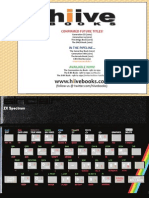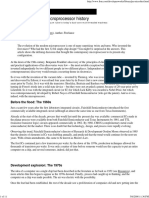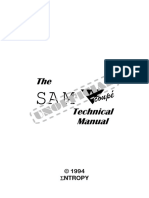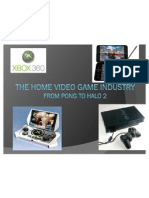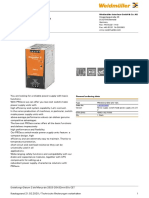0 ratings0% found this document useful (0 votes)
683 viewsSinclair and The Sunrise Technology
Sinclair and The Sunrise Technology
Uploaded by
Jason BrownThe ZX80 was Sinclair's first personal computer launched in 1980 at the extremely low price of £99.95 due to its minimal components and use of a television and cassette player. It was an immediate success, selling over 10,000 units. In 1981, the improved ZX81 was launched with a new chip replacing 18 chips in the ZX80, lowering the price further. By early 1982 over 300,000 ZX81 computers had been sold worldwide, establishing Sinclair as a leader in the new personal computer market and opening the sector to a mass audience.
Copyright:
Attribution Non-Commercial (BY-NC)
Available Formats
Download as DOC, PDF, TXT or read online from Scribd
Sinclair and The Sunrise Technology
Sinclair and The Sunrise Technology
Uploaded by
Jason Brown0 ratings0% found this document useful (0 votes)
683 views7 pagesThe ZX80 was Sinclair's first personal computer launched in 1980 at the extremely low price of £99.95 due to its minimal components and use of a television and cassette player. It was an immediate success, selling over 10,000 units. In 1981, the improved ZX81 was launched with a new chip replacing 18 chips in the ZX80, lowering the price further. By early 1982 over 300,000 ZX81 computers had been sold worldwide, establishing Sinclair as a leader in the new personal computer market and opening the sector to a mass audience.
Original Description:
Sinclair - The ZX Spectrum and ZX81
Copyright
© Attribution Non-Commercial (BY-NC)
Available Formats
DOC, PDF, TXT or read online from Scribd
Share this document
Did you find this document useful?
Is this content inappropriate?
The ZX80 was Sinclair's first personal computer launched in 1980 at the extremely low price of £99.95 due to its minimal components and use of a television and cassette player. It was an immediate success, selling over 10,000 units. In 1981, the improved ZX81 was launched with a new chip replacing 18 chips in the ZX80, lowering the price further. By early 1982 over 300,000 ZX81 computers had been sold worldwide, establishing Sinclair as a leader in the new personal computer market and opening the sector to a mass audience.
Copyright:
Attribution Non-Commercial (BY-NC)
Available Formats
Download as DOC, PDF, TXT or read online from Scribd
Download as doc, pdf, or txt
0 ratings0% found this document useful (0 votes)
683 views7 pagesSinclair and The Sunrise Technology
Sinclair and The Sunrise Technology
Uploaded by
Jason BrownThe ZX80 was Sinclair's first personal computer launched in 1980 at the extremely low price of £99.95 due to its minimal components and use of a television and cassette player. It was an immediate success, selling over 10,000 units. In 1981, the improved ZX81 was launched with a new chip replacing 18 chips in the ZX80, lowering the price further. By early 1982 over 300,000 ZX81 computers had been sold worldwide, establishing Sinclair as a leader in the new personal computer market and opening the sector to a mass audience.
Copyright:
Attribution Non-Commercial (BY-NC)
Available Formats
Download as DOC, PDF, TXT or read online from Scribd
Download as doc, pdf, or txt
You are on page 1of 7
The Sinclair Story
Sir Clive's
success.
Z80 and The second
and final
extract from
beyond Rodney
Dale's Sinclair
Story
SINCLAIR'S SUCCESS had always been based on being
first with products, often aimed at a market that didn't know
it existed. By 1979 there was a well established 'personal
computer' market. Commodore had launched its £700 PET
home computer the previous year. Apple and Tandy were
also well known in the field. These machines were found
variously in laboratories, and commercial and teaching
establishments; not many people had a computer at home.
Sinclair decided that he would have to offer a product with
all the essential features but at a greatly reduced price. In
May 1979 The Financial Times predicted: "Personal
computers will become steadily cheaper and their price could
drop to around £100 within five years." Typically, Sinclair
decided to do it in a few months!
The ZX80 - the world's smallest and cheapest computer -
was launched at an exhibition in Wembley at the end of
January 1980. It measured 9" x 7" and cost £99.95, or £79 in
kit form.
In order to keep the price low the designers had to introduce some radical ideas to reduce vastly the
number of components. The biggest saving was the use of a domestic television set as a screen and a
cassette player as a program and data store. The machine had a Z80A microprocessor which was
supplied by Nippon Electric; a large ROM, which contained a 4K-byte specially written Basic
interpreter, the character set and monitor; and the interfacing circuitry.
The ZX80 was very much aimed at the person in the street wanting to know something about
programming computers. Sinclair was convinced that people could be persuaded to buy the ZX80 but
how to persuade them was the problem. The image of the computer at that time was somewhat Big
Brother; clinical, air-conditioned surroundings; huge cabinets with reels of magnetic tape whirring to
and fro. How would people relate such a frightening piece of equipment to the ZX8O? Why would they
want to buy it for the home? Why would they want to buy it at all?
No one need have worried. The ZX80 was an immediate
success; ten orders were placed at the exhibition in the first
five minutes. The office in King's Parade was suddenly
inundated with cheques; the switchboard was permanently
jammed. Nobody had expected quite such a response and there
was total chaos. Clive's immediate problem was to ensure that
the company could cope efficiently both with the
administration, and with the production of the ZX80.
Sinclair wanted to sell the ZX80 in the United States, although
he did not expect to find an enormous market there because of
the strength of the competition in the home computer field.
However, a few weeks before the launch of the ZX80 in the
UK he took it to the Las Vegas Consumer Electronics Show,
and at the same time met Nigel Searle in Boston. Within a few
days Searle had a new job, a new apartment and an office in
Boston. He sold the ZX80 and later the ZX81 in the States
from that office by mail order until early 1982.
Sinclair Research expanded rapidly; by September 1980, over
20,000 ZX80s had been sold. Clive Sinclair was determined to
keep the company to a manageable size; he was all too aware
of the need to try to learn from previous mistakes. Bringing
manufacturing in-house in the days of Sinclair Radionics had
seemed an excellent idea at the time, but the number of people
they had had to make redundant had hurt him deeply.
By this time there were 12 employees at the King's Parade
offices in Cambridge, six engineers still working at The Mill in
St Ives, and Nigel Searle in Boston. To make sure that the
company didn't grow too fast Sinclair had subcontracted all
manufacturing. To begin with, production was done locally in
St Ives by Tek Electronics. Components were generally of a
much higher standard than they had been during the Black
Watch fiasco, so there was less reason to manufacture products
in-house. Eventually, as more and more were produced, the
computers were made by Timex in Dundee; it is a testimony to all concerned that the return rate on the
ZX80 was only one per cent.
Although the machine was so popular and sold so well, this was largely because it had no competitors.
In fact it did have some drawbacks such as the lack of floating point arithmetic, a capacity of only five
digits and an inability to handle separate files on its cassettes. The touch-sensitive - or sometimes
touch-insensitive - keyboard was unpoular with users too.
But in spite of those shortcomings, the ZX80 had opened a new market sector which exceeded
Sinclair's wildest dreams, so who was going to complain too loudly? In September 1980, the company
launched a 16K RAM pack - an extra plug-in memory - to attach to the edge-connector at the back of
the machine. There will be many who remember the well-known RAM pack problem whereby a slight
breeze could upset the connection and an evening's work would be lost. Thank heavens for Blu-Tack.
The ZX81 was launched in March 1981. It contained a new chip, designed by Sinclair Research and
manufactured by Ferranti - the world leader in uncommitted logic arrays standard chips which can be
adapted to a user's requirements at the last stage of production. The new chip replaced 18 chips in the
ZX80 and the machine now retailed at £69.95 or £49.95 in kit form. Sinclair also offered an add-on
ROM to convert the ZX80 to the ZX81.
The ZX81 had a floating decimal point and scientific functions. It came in a sturdy black case and, if
you used a colour TV, would produce black characters on a restful green background. It was a vast
improvement on the ZX80. Sinclair also announced that he would be launching a small printer to work
with the ZX81 later in the year.
Now that he had an improved machine and the promise of a printer, Sinclair decided to fight back at the
government's scheme by offering his own half-price deal. Schools could buy a package of a ZX81 and
a 16K RAM pack for £60; and he further promised that they would be able to buy the ZX Printer at half
price when it was launched. That made the total cost of system £90, while under the government
scheme the minimum a school could pay if it bought an 'approved system' was £130. About 2300
schools purchased the Sinclair package.
The ZX81 received a very sympathetic review from David Tebbitt
in Personal Computer World in which he keeps referring to 'Uncle
Clive'. On the other hand: "Sinclair has been a bit cheeky in his
advertisements. Under a column entitled 'New, improved features',
he proceeds to mention three things that were included in the ZX80
when it was launched over a year ago!"
The ZX Printer was eventually launched in November 1981 at
£49.95. Designed for the ZX81, it could also be used with the ZX80
with an 8K ROM. It was a very compact little printer using a special
metallised paper, and would print 32 characters to a line and nine
lines to the inch. You plugged it m to the edge connector at the back
of the computer using a stackable socket. The print was clear and
readable; the ZX Printer sold well.
Sir Clive dons his running shorts The market gradually expanded. In March 1981 Mitsui approached
Sinclair Research and towards the end of the year was granted
exclusive distribution rights for the ZX81 in Japan. Mitsui was one
of Japan's main importers of British goods, the range including Jaguar cars and Burberry raincoats.
They planned to market the ZX81 by mail order at about £90 and aimed at selling 20,000 computers
during the first year; there were no competitors.
By the end of January 1982, 300,000 ZX81s had been sold worldwide. In the USA Sinclair was selling
15,000 personal computers a month by mail order; American Express was selling thousands to a
potential ten million customers. Then Timex was granted a licence to market both current and future
Sinclair personal computer products in the US from mid-1982. They paid Sinclair a five per cent
royalty for sales and bought the right to use the Sinclair name in the US.
In Britain, Sinclair signed an agreement to sell the ZX81 through the branching-out stationers and
booksellers WH Smith. Today, when so many national stores - Boots, Dixons, John Lewis, and the rest
- have sections devoted to matters computery, it is hard to remember what a breakthrough it was to be
able to buy the ZX81 in the High Street. Not that other makers were far behind; the numerous retail
outlets were just one of the ways in which the home computer created jobs. By February 1982
production of ZX81s was running at about half a million machines a year and the company had a
turnover of £30M compared to £4.65M in the year ended March 1981.
One of the interesting side-effects of the ZX80 and ZX81 was the number of cottage industries that
sprang up because of them, producing software, peripherals and publications. A ZX80 Users' Club had
been formed before the ZX81 was launched; SYNC Magazine appeared in January 1981 to cater for
ZX81 users; Learning Basic with your Sinclair ZX80 by Robin Norman, published by Newnes in early
1981, was one of the first books to develop Basic programming techniques on the home computer.
Hundreds of small operations started to sell programs, books, extra
memory, printers, sound generators and add-on keyboards for use
with the ZX81. In January 1982 one Mike Johnston organised a fair
for companies selling products for the Sinclair computers. Nearly
10,000 people turned up at Central Hall, Westminster, which has a
capacity for only a few hundred; the police had to be called to
control the crowds; 70 exhibitors took huge sums of money.
Both the ZX80 and ZX81 had been produced as learning machines;
for the person wanting to find out about computer programming.
Once people knew what they were doing they wanted a more
powerful machine, and at first they had to turn to manufacturers Nigel Searle in Boston
other than Sinclair Research to find them.
Sinclair's philosophy - at least in retrospect - was to prepare the
world for universal computer ownership in easy stages. Over 50,000 ZX80s had been sold, and more
than six times as many ZX81s. As the market matured, the engineers were working away at the ZX82
(codename) which was launched as the ZX Spectrum in April 1982. The hardware was designed by
Richard Altwasser, who later formed his own company, Cantab, and fell by the wayside in an attempt to
market a computer called the Jupiter Ace. The software was written by Steve Vickers on contract from
Nine Tiles Ltd - the company which had originally provided Sinclair Basic.
Production of the Spectrum started at 20,000 a month and Sinclair expected to sell 300,000-400,000
during the first year. There were two versions: the 16K sold for £125 and the 48K for £175. For those
who preferred to work up in easy stages, an extra pack to increase the memory of the cheaper machine
was available for £60.
In many ways the Spectrum was altogether a 'better'
machine than either the ZX80 or ZX81, although
some said its predecessor the ZX81 was superior
when it came to finding out how computers actually
work. Its chief advantages over the ZX81 were
'eight-colour graphics capability, sound generator,
high-resolution graphics - smaller dots on the screen
- and many other features, including the facility to
support separate data files.'
At last, Sinclair Research was notionally able to
The Timex plant in Dundee compete with the BBC Micro and other personal
computers; the figures in the table published in the
ZX Spectrum leaflet were impressive. The ZX81 had
been competing against the Acorn Atom; it could never have stood up against the BBC model A, the
current Acorn competitor when the Spectrum came out. The Spectrum had a more versatile Sinclair
Basic than the previous two machines; an improved keyboard replaced the unpopular - though cheap -
touch-sensitive keyboard; it was able to generate and display graphics using up to eight colours; and it
could be linked to other Spectrums to create a communications network.
However when Jim Lennox reviewed the new machine for the late lamented Technology Week, he was
not impressed by the keyboard - which had been made to simulate moving keys by fitting a one-piece
moulded rubber pad over a ZX81-type membrane keyboard, and which had a most peculiar feel to it.
The Spectrum was the cheapest home computer to produce colour graphics but the reviewer
complained of the lack of facilities and 'found that the borders tend to wriggle in an irritating way'. It
also had a small built-in loudspeaker which generated bleeps 'acceptable for games, but not much
more'. And that, to Sinclair's disappointment, was about all the Spectrum was generally used for. The
tone of the review was set in the first paragraph:
"After using it, however, I find Sinclair's claim that it is the
most powerful computer under £500 unsustainable.
Compared to more powerful machines, it is slow, its colour
graphics are disappointing, its Basic limited and its keyboard
confusing."
But never mind the reviewers; the Spectrum is without doubt
the most commercially successful home computer ever. It
was after the launch of the Spectrum that computer fever
really took off; children were being introduced to computers
at school and the very cheapness of the ZX80 and 81 meant
that parents were prepared to buy them to give their children
'a good start in life'.
Sinclair's headquarters in Cambridge
The place of the computer in the home was reinforced by the
meagre provision in schools, where there was often only one
machine between 30 pupils and thus insufficient opportunity
for everyone to practise. What better solution than a computer at home?
But Sinclair observed another dimension: "The interesting thing is that as well as children being expert
at programming, there is another expert group taking to it like ducks to water - retired people. The
concept of it being peculiarly suitable to the young mind is perhaps wrong - it's the mind that's free of
everyday burdens. The retired person with some time to spare can take to it wonderfully and it's giving
a lot of people a new interest in life."
The first home computers had no software; to play a game on one
you either had to make it up yourself or buy a magazine with a
program in it - which was very good for the magazine industry - and
type in the program before you could start to play. Now the
Spectrum with its 48K memory was capable of playing very
sophisticated games and there were companies starting up solely to
produce them - often run by very young people who had learnt
programming at school or from magazines.
In February 1983, WH Smith, who had been the Spectrum's biggest
distributor, was joined by Boots, Currys, Greens - Debenham's in-
store subsidiary - and John Menzies as Sinclair pioneered a change
The launch of the Spectrum
in the High Street. Many other stores such as John Lewis and the
House of Fraser were supplied by Sinclair's UK distributor, Prism
Micros. 200,000 Spectrums had now been sold by mail order, and by Easter 12-15,000 Spectrums were
being sold per week in the UK. The Spectrum had also been launched in more than 30 countries
worldwide.
You couldn't walk into WH Smith on a Saturday without being faced with shelves of software and
mobiles and whizz-kids playing on the computers. What sort of computer you had became an important
factor in playground status.
And where has it all led? Computer awareness has been generally raised; the dust has settled, much of
it on the home computers, leaving a hard core of enthusiasts. The market is saturated; the craze is over.
The computer is settling into a serious niche comparable with ham radio; the days of the CB computer
are surely over.
Sinclair Story Part 1 (Issue 45)
Sinclair User
January 1986
You might also like
- Manual Settlers 1993Document138 pagesManual Settlers 1993Timothy Hamel50% (2)
- Sinclair ZX Spectrum BASIC ProgrammingDocument116 pagesSinclair ZX Spectrum BASIC ProgrammingBrandon Mcguire0% (1)
- The ZX Spectrum Book - 1982 To 199xDocument260 pagesThe ZX Spectrum Book - 1982 To 199xMattyLCFC100% (1)
- ZX 81 Basic ProgrammingDocument217 pagesZX 81 Basic Programmingsjag3No ratings yet
- Microcomputers FundamentalsDocument953 pagesMicrocomputers Fundamentalsdebelaberta100% (2)
- Timex Sinclair 2068 Beginner / Intermediate GuideDocument270 pagesTimex Sinclair 2068 Beginner / Intermediate GuideremowNo ratings yet
- RetroMagazine 06 EngDocument67 pagesRetroMagazine 06 Engionut76733No ratings yet
- Pocket ZX Handheld ZX SpectrumDocument15 pagesPocket ZX Handheld ZX SpectrumDavid ClodeNo ratings yet
- A1200 Users Guide (UK)Document75 pagesA1200 Users Guide (UK)MalcolmNo ratings yet
- Easy Add-On Projects For Spectrum Zx81 and AceDocument189 pagesEasy Add-On Projects For Spectrum Zx81 and AceArkinuxNo ratings yet
- Master Memory MapDocument308 pagesMaster Memory MapgamerhobbistaNo ratings yet
- Timex Sinclair 1000 - ZX81 DifDocument2 pagesTimex Sinclair 1000 - ZX81 DifOscar Arthur KoepkeNo ratings yet
- English ZXDOS+ and gomaDOS+ ManualDocument131 pagesEnglish ZXDOS+ and gomaDOS+ ManualPollonezNo ratings yet
- Great Moments in Microprocessor HistoryDocument11 pagesGreat Moments in Microprocessor Historyrandima fernandoNo ratings yet
- AmigaActive 09 2000Document68 pagesAmigaActive 09 2000api-3824268No ratings yet
- Commodore Magazine Vol-09-N03 1988 MarDocument132 pagesCommodore Magazine Vol-09-N03 1988 MarSteven DNo ratings yet
- AtariDocument228 pagesAtaridvegaucentral100% (1)
- Atari ST BASIC Sourcebook Part1Document58 pagesAtari ST BASIC Sourcebook Part1smansierNo ratings yet
- Atari 5200 EPROM Cart TiltoDocument3 pagesAtari 5200 EPROM Cart TiltoOscar Arthur KoepkeNo ratings yet
- Atari Microsoft Basic - Atari 800Document167 pagesAtari Microsoft Basic - Atari 800jorevfNo ratings yet
- HomePak User ManualDocument146 pagesHomePak User ManualremowNo ratings yet
- Real MIDI Out On ZX Spectrum 128KDocument1 pageReal MIDI Out On ZX Spectrum 128KleftNo ratings yet
- STalker 3Document88 pagesSTalker 3remowNo ratings yet
- CrackingCodeZXSpectrum PDFDocument270 pagesCrackingCodeZXSpectrum PDFManolo GarciaNo ratings yet
- ZX81 ServiceManualAndAssemblyInstructions PDFDocument43 pagesZX81 ServiceManualAndAssemblyInstructions PDFViorel AldeaNo ratings yet
- MOS TechnologyDocument5 pagesMOS TechnologydjtomcraftNo ratings yet
- Ian O. Angell, Brian J. Jones (Auth.) - Advanced Graphics With The Sinclair ZX Spectrum-Macmillan Education UK (1983)Document265 pagesIan O. Angell, Brian J. Jones (Auth.) - Advanced Graphics With The Sinclair ZX Spectrum-Macmillan Education UK (1983)T. SinkNo ratings yet
- Compute's Third Book of Commodore 64 PDFDocument322 pagesCompute's Third Book of Commodore 64 PDFDamiano Tsichlias100% (1)
- TVTCBDocument260 pagesTVTCBAndrew Ayers100% (1)
- Copy/Paste: Daddarulekonge 2016 - (V2) 2021Document406 pagesCopy/Paste: Daddarulekonge 2016 - (V2) 2021n9ywbtkcdxNo ratings yet
- Commodore 64 An Introduction To BASIC - Part 1Document153 pagesCommodore 64 An Introduction To BASIC - Part 1Delfin ButlonosyNo ratings yet
- Puter WarsDocument110 pagesPuter WarsRory WinstonNo ratings yet
- Spectrum Operating System TheDocument71 pagesSpectrum Operating System ThePrzemysław WójcikNo ratings yet
- The AmigaDocument388 pagesThe AmigaJose Antonio VilariñoNo ratings yet
- Commodore Magazine Vol-10-N01 1989 JanDocument132 pagesCommodore Magazine Vol-10-N01 1989 JanSteven DNo ratings yet
- The Story of The Commodore Amiga in PixelsDocument292 pagesThe Story of The Commodore Amiga in PixelsMatt WheelerNo ratings yet
- COMAL 80 For The Commodore 64Document324 pagesCOMAL 80 For The Commodore 64Chris HarkerNo ratings yet
- The Story of The Sinclair ZX Spectrum in PixelsDocument236 pagesThe Story of The Sinclair ZX Spectrum in PixelsMatt Wheeler100% (1)
- Run Issue 07 1984 JulDocument150 pagesRun Issue 07 1984 JulGeoffrey de VlugtNo ratings yet
- Amiga Graphics Inside and OutDocument624 pagesAmiga Graphics Inside and OutAsaf Ayoub100% (3)
- Atari Basic Reference GuideDocument132 pagesAtari Basic Reference GuideDjayBeeNo ratings yet
- Intellivision Controller Pinouts TiltoDocument2 pagesIntellivision Controller Pinouts TiltoOscar Arthur KoepkeNo ratings yet
- SAM Coup Technical ManualDocument41 pagesSAM Coup Technical ManualzbytiNo ratings yet
- Fusion AmigaDocument52 pagesFusion Amigamaferio100% (1)
- Arcade Games For The Commodore 64 PDFDocument226 pagesArcade Games For The Commodore 64 PDFRickAstoria0% (1)
- ZX Spectrum Game MasterDocument83 pagesZX Spectrum Game MasterJakub Fikołek100% (1)
- Commodore Power-Play 1985 Issue 17 V4 N05 Oct NovDocument132 pagesCommodore Power-Play 1985 Issue 17 V4 N05 Oct NovSteven D100% (1)
- ZX Spectrum 128 Service ManualDocument65 pagesZX Spectrum 128 Service Manuallugo76No ratings yet
- Commodore Magazine Vol-09-N06 1988 JunDocument132 pagesCommodore Magazine Vol-09-N06 1988 JunSteven DNo ratings yet
- Atari 800 Hardware Manual, Part1Document9 pagesAtari 800 Hardware Manual, Part1rybagz100% (1)
- The Home Video Game IndustryDocument17 pagesThe Home Video Game Industrysureshghanta88No ratings yet
- Repair of An Atari 130xe ComputerDocument3 pagesRepair of An Atari 130xe ComputergamerhobbistaNo ratings yet
- Amiga Machine Language 1991 AbacusDocument276 pagesAmiga Machine Language 1991 AbacusTeeNo ratings yet
- Commodore Magazine Vol-09-N01 1988 JanDocument132 pagesCommodore Magazine Vol-09-N01 1988 JanSteven D100% (3)
- Amiga 500 IntroductionDocument294 pagesAmiga 500 IntroductionMalcolmNo ratings yet
- 200512Document191 pages200512Anonymous 9ufCY3No ratings yet
- Amiga:: The Computer That Wouldn't DieDocument7 pagesAmiga:: The Computer That Wouldn't DieatarifanNo ratings yet
- WSN Chapter 3Document75 pagesWSN Chapter 3sanyukta246No ratings yet
- Chinese DVA PDFDocument8 pagesChinese DVA PDFSOMNATH KHAMARUNo ratings yet
- V. Mosfet PDFDocument33 pagesV. Mosfet PDFleeminho_janxiNo ratings yet
- RX Family: Application NoteDocument30 pagesRX Family: Application NoteJagAnandNo ratings yet
- Fault Tolerance in FPGA Through Horse Shifting PDFDocument5 pagesFault Tolerance in FPGA Through Horse Shifting PDFNoah OkitoiNo ratings yet
- PROFIBUS Slave Step7 2.1Document30 pagesPROFIBUS Slave Step7 2.1Johana Carolina BetancurNo ratings yet
- 3728lxff PDFDocument38 pages3728lxff PDFMaria Aleici JerezNo ratings yet
- Edge+ Device EvolutionDocument14 pagesEdge+ Device EvolutionPreeda T VanichNo ratings yet
- Synopsis On 8 Canmdidate Quiz BuzzerDocument4 pagesSynopsis On 8 Canmdidate Quiz BuzzerArun Kumar YadavNo ratings yet
- PRO ECO 240W 24V 10A PTDocument5 pagesPRO ECO 240W 24V 10A PTJosé CarlosNo ratings yet
- Environmental Monitoring: Monitoring and Control of Photovoltaic SystemsDocument11 pagesEnvironmental Monitoring: Monitoring and Control of Photovoltaic SystemsVasluianuNo ratings yet
- Drawing Package For Schneider RMU-Layout6Document1 pageDrawing Package For Schneider RMU-Layout6mohammedasheem891No ratings yet
- TM SB 22 PTDocument140 pagesTM SB 22 PTDag Ståle KarlsenNo ratings yet
- Cyclone® V Device Family Pin Connection Guidelines PCG-01014-2.8Document70 pagesCyclone® V Device Family Pin Connection Guidelines PCG-01014-2.8Clyde CauchiNo ratings yet
- Microprocessors and Interfacing Devices PDFDocument160 pagesMicroprocessors and Interfacing Devices PDFNimish BansalNo ratings yet
- Tok T0101Document25 pagesTok T0101alllim88No ratings yet
- NTC DatasheetDocument15 pagesNTC DatasheetSUNILNo ratings yet
- PC AssembleDocument84 pagesPC AssembleRoselyn Morga-CervantesNo ratings yet
- 1MRG009835 en Application Note 87T For Step-Up Transformer Consisting of Three Single-Phase Units PDFDocument5 pages1MRG009835 en Application Note 87T For Step-Up Transformer Consisting of Three Single-Phase Units PDFrajeshNo ratings yet
- Sharp 14BM2G 523522 20 9 2009Document40 pagesSharp 14BM2G 523522 20 9 2009JTsinineNo ratings yet
- Tube Selection GuideDocument58 pagesTube Selection GuideandyNo ratings yet
- Dot Matrix LCD 40-Channel Driver: FeaturesDocument9 pagesDot Matrix LCD 40-Channel Driver: FeaturesSpecShareNo ratings yet
- Villanuva, A, ElecsDocument25 pagesVillanuva, A, ElecsAaron VillanuevaNo ratings yet
- SRAM Design: MemoryDocument36 pagesSRAM Design: MemoryChia-Cheng LiaoNo ratings yet
- Changhong+HLS80JS+JUC7 820 00208835-3Document43 pagesChanghong+HLS80JS+JUC7 820 00208835-3Jojo SaraivaNo ratings yet
- FIFO Chip Design ExampleDocument79 pagesFIFO Chip Design ExampleramachandraNo ratings yet
- Using LabVIEW: Simulation Exciter of Devices JammingDocument11 pagesUsing LabVIEW: Simulation Exciter of Devices JammingInternational Journal of Basic and Applied ScienceNo ratings yet
- E6412 - M5A97 EVODocument0 pagesE6412 - M5A97 EVOCiro JustoNo ratings yet
- BC547 PDF, BC547 Description, BC547 Datasheets, BC547 View - ALLDATASHEETDocument4 pagesBC547 PDF, BC547 Description, BC547 Datasheets, BC547 View - ALLDATASHEETbobsilloNo ratings yet



